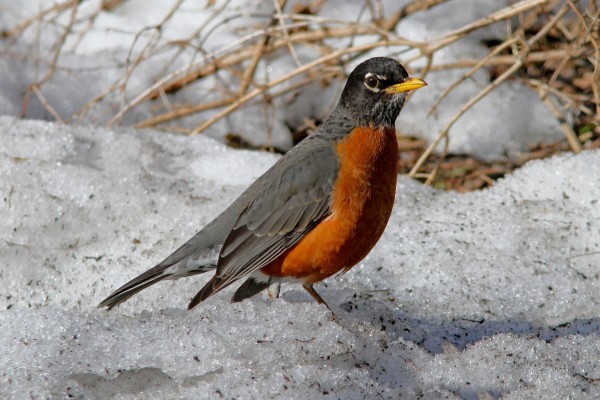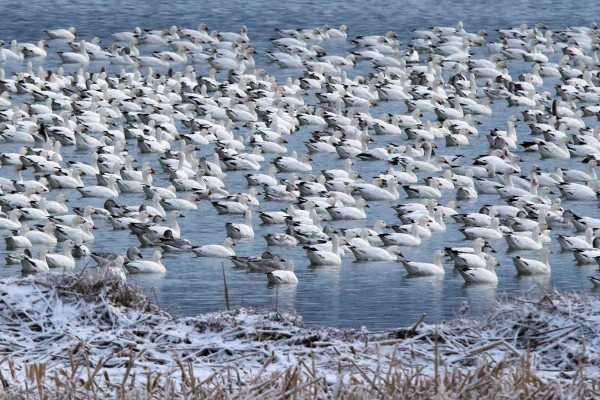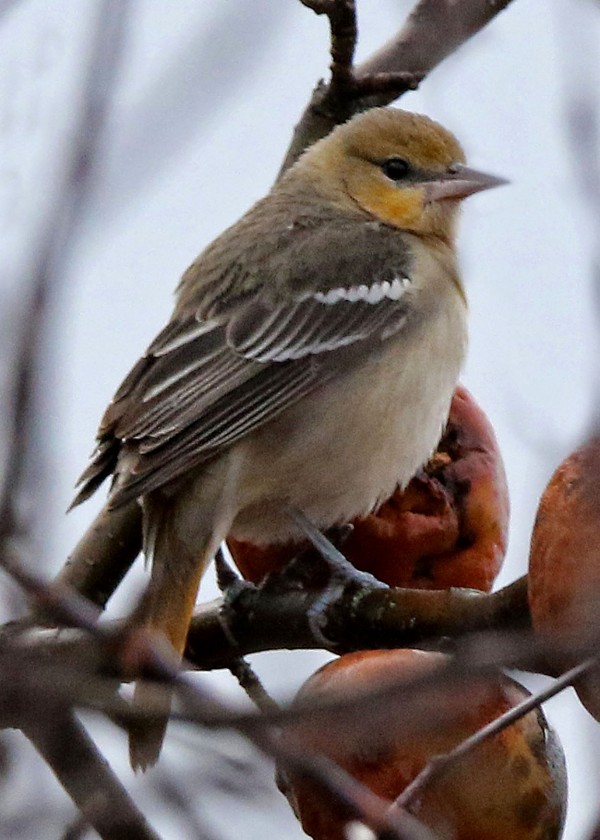
Each year can be a new surprise
Text & Photo by Brian Morin
“Can you believe it, I just saw a Robin! That must mean spring is coming early.” Well, not likely. While most Robins head further south for the winter, it is not uncommon to find a few that brave the elements. There are always some present in southern Ontario but even in Eastern and Central Ontario we can be surprised
That’s the thing about birds. Just because most spend the winter in the south, a few individuals linger well past their normal departure date. Some even manage to make it through the worst of what Old Man Winter throws at us and end up getting a head start on spring activity.
A few years ago, when we had a mild fall, there were many Robins that stuck around to be recorded on Christmas bird counts, with flocks of dozens to over a hundred present in Eastern Ontario. The Massena N.Y. – Cornwall Ontario count in 2011 had a staggering 1,609. That winter many Robins remained until spring, finding berries and fruit wherever they could. The combination of ample food and a winter that was tolerable made for interesting conversations among surprised observers. Stories in newspapers and on TV appeared throughout the winter.
Waterfowl usually offer us the greatest number of lingering individuals of any family. I’m sure that most of us have seen at least a few Canada Geese and Mallards in the depths of winter. The majority of these birds move on but areas with open water likely have some present. Every few years, thousands may be encouraged to hang around until ice prevents them from roosting for the night. While they may find some food in the water, dabbling ducks and geese will often feed on stubble in fields during the day, retreating to the safety of open water for the night.
One of the greatest wildlife spectacles anywhere, happens about 30 minutes east of Ottawa and can last until Christmas. Each October, tens of thousands of Snow Geese settle into fields near Casselman and will stick around until there is too much snow on the fields to feed. The number is jaw dropping. At the peak in early November there can be close to 100,000 present with as many as 30,000 remaining well into December. They will vanish after a substantial snowstorm has passed.
These birds are highly visible to everyone, but many other lingering birds may go largely unnoticed. Small songbirds can easily be passed over and may only be present as individuals. That’s where feederwatchers come in. There is an army of attentive people that keep local naturalists informed on the comings and goings in their yards. While most would not consider themselves experienced observers, they do know their regulars.
They are certainly familiar with the Chickadees, nuthatches, woodpeckers and the like that frequent their yards year-round. They may also know some of the winter finches, Mourning Doves and of course Blue Jays. It is when something different shows up that they wonder what they’ve got. After checking a field guide or doing an online search, they discover they have something unusual.
There are many possible songbirds that can put in an appearance, with names such as Gray Catbird, Brown Thrasher, White-throated Sparrow, Red-winged Blackbird, Cowbird and Yellow-rumped Warbler to mention a few. Most can subsist on a seed diet although for some suet is essential. Neither would appeal to a bird like a Baltimore Oriole. This is a fruit and berry eater when there are no insects present. It would be difficult for an oriole, tanager and other birds that should be very far south to survive an Eastern Ontario winter.

Occasionally we get surprise visitors, birds that shouldn’t be here at all. They are wayward travellers, often from the West but sometimes from the South. They are far from home having taken a wrong turn, landing in your yard. Over the years, individuals such as Varied Thrush, Black-headed Grosbeak, Painted Bunting, Summer Tanager, Yellow-throated Warbler and Townsend’s Solitaire have all showed up in yards to the delight of feederwatchers and those who came to see them.
The regional star in Eastern Ontario during the winter of 2015 was an unusual oriole. When it was found in late November in Pakenham it was first thought to be a female Bullock’s Oriole from the West. It survived for over a month on apples but it was rescued in early January and sent to the Wild Bird Care Centre in Ottawa when brutally cold weather set in. Keen birders had a feather sample analyzed and DNA testing indicated the bird was a hybrid Bullock’s x Baltimore Oriole. We all learned from that experience.
Who knows what lies in store this winter but with keen eyes we are certain to be treated to exciting birding surprises once again.
Brian Morin is the publisher of Ontario Birding News, a newsletter for birding enthusiasts. He has been actively involved in watching and photographing birds in Ontario for more than 40 years.







